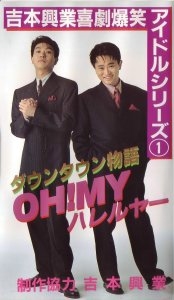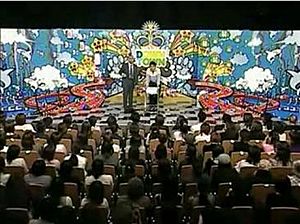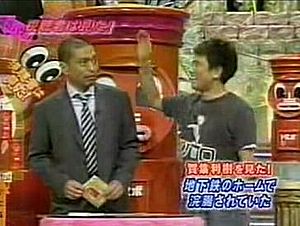Downtown (owarai) facts for kids
Quick facts for kids Downtown |
|
|---|---|
| Pseudonym | Hama-chan and Mat-chan (浜ちゃんと松ちゃん) |
| Native name | Dauntaun (ダウンタウン) |
| Years active | 1982–present (formed in Hyogo Prefecture) |
| Employer | Yoshimoto Kogyo |
| Genres | Manzai, conte |
| Members |
|
|
Same year/generation as:
Tommys High Heele |
|
Downtown (ダウンタウン, Dauntaun) is a super famous Japanese comedy duo. It's made up of two comedians, Hitoshi Matsumoto and Masatoshi Hamada, who are both from Amagasaki, Hyōgo. They started working together in 1982 and are now one of the most important and successful comedy duos in Japan.
They are well-known for their stand-up comedy acts and for hosting many popular Japanese variety shows. Some of their most famous shows include Downtown no Gaki no Tsukai ya Arahende!!, Hey! Hey! Hey! Music Champ and Wednesday's Downtown. They often use a funny, sometimes sarcastic, and quick-tempered style in their performances.
Because they are so popular and work for a big company called Yoshimoto Kogyo, the Kansai dialect (which they both speak) has become strongly linked with Japanese comedy, known as owarai. Many students at comedy schools say that Matsumoto and Hamada are their biggest inspirations.
Contents
Meet the Members
Masatoshi Hamada
Masatoshi Hamada was born on May 11, 1963, in Naniwa-ku, Osaka, and grew up in Amagasaki, Hyōgo. In their comedy acts, he plays the tsukkomi role. This means he's usually the straight man who reacts to the funny things his partner says. He is married and has two sons. People also call him "Hama-chan" (浜ちゃん). He's known for his energetic reactions and sometimes playfully hitting his partner on the head.
Hitoshi Matsumoto
Hitoshi Matsumoto was born on September 8, 1963, in Amagasaki, Hyōgo. He plays the boke role in the duo. The boke is the funny one who says silly things or makes mistakes. People often call him "Mat-chan" (松ちゃん). His comedy style includes being a bit sarcastic and having a calm, serious face, but he can also show big, funny reactions.
How They Started
Childhood and School Days
Matsumoto and Hamada first met when they were in Ushio Elementary School in Amagasaki, Hyōgo. They became good friends in junior high school. They both joined the school's broadcasting club. It was then that Matsumoto jokingly suggested they become a comedy duo, and the idea stuck with them.
Later, Matsumoto's comedy partner from another group had a fight with Hamada. Hamada won the fight, and Matsumoto decided to leave with him. This moment was the start of their journey together as Downtown.
They went to different high schools. Hamada's boarding school was very strict, and he tried to escape many times. When he did, he would call Matsumoto for help and hide at his house. Matsumoto, on the other hand, went to a local tech school.
Early Career

After high school, Hamada tried to become a motorboat racer but it didn't work out. He then asked Matsumoto to join him in becoming a comedian. Matsumoto had another job offer, but he chose to join Hamada. They decided to join Yoshimoto Kogyo's comedy school, NSC, in Osaka.
Their first stage name was "Matsumoto Hamada." They tried a few other names like "The Wright Brothers" before finally choosing "Downtown" from a magazine. They officially started their comedy career in 1983.
In their early days, Downtown didn't always get laughs from the audience. Sometimes, people even shouted insults at them. They tried to put on their own shows, but it was hard to get people to watch, even for free. Matsumoto has said these early years were very tough. They even thought about quitting at one point. They didn't earn much money, so they lived with their parents and traveled to the city for shows.
Rise to Popularity
Even with the difficulties, Downtown slowly gained more fans and became more well-known. In April 1987, four years after they started, they began hosting a local TV show called Yoji Desu Yōda. This show quickly made them super popular in their region, especially among high school girls. They even released music and photo books!
After a big farewell concert, they moved to Tokyo in 1989. They appeared on some smaller TV shows before getting their big break with the long-running variety show Downtown no Gaki no Tsukai ya Arahende!!. From then on, they created many other successful variety shows, like Downtown no Gottsu Ee Kanji, Downtown DX, and the music show Hey! Hey! Hey! Music Champ.
Their Comedy Style
Boke and Tsukkomi
Like many Japanese comedy duos, Downtown has a boke and a tsukkomi. Matsumoto is the boke, who says funny or silly things. Hamada is the tsukkomi, who reacts to Matsumoto's jokes, sometimes with a playful tap on the head. Hamada is also known for reacting strongly to other celebrities who make funny mistakes on their shows.
Sometimes, they even switch their roles for a skit, which makes their comedy even more surprising and funny!
Manzai

In the early 1980s, most manzai (a type of stand-up comedy) was fast-paced. But Downtown did things differently. They used a slower, more relaxed style that surprised older comedians. While other duos faced the audience, Downtown would often face each other, talking as if no one else was there.
Their unique style changed manzai forever, and many new comedians have copied parts of their approach. It's special that Downtown never had a mentor (an older comedian to train them). This helped them create their own unique style.
At first, many people thought Downtown's slow style was too different to succeed. But then, a famous manzai comedian named Shinsuke Shimada saw them perform. He was so impressed by how funny and clever they were that he decided to retire from manzai himself! He said Downtown was the main reason. Downtown later became very dominant in manzai in the late 1980s and early 1990s.
Matsumoto and Hamada are now seen as "geniuses" in their comedy roles. They have worked hard to improve their skills. They are also willing to make fun of themselves, even after becoming very popular. This is clear in shows like Gaki No Tsukai, where they go through many funny challenges and "punishment games." These roles are usually for newer comedians, but Matsumoto and Hamada enjoy them even though they are at the top of Japanese entertainment.
Downtown hasn't performed a traditional manzai routine since 1991. However, their free talk sessions on Gaki No Tsukai are seen as a modern version of their manzai style.
Kansai Dialect
Yoshimoto Kogyo, their comedy company, is based in the Kansai region of Japan. Most of its comedians speak Kansai-ben, a strong and lively dialect from Osaka.
Matsumoto and Hamada have always used this dialect, and it's a big part of their comedy. They even use it in the titles of their TV shows. For example, Gaki no Tsukai ya Arahende means "Not An Errand Boy!" in Kansai-ben. Downtown's popularity has made many of these Kansai expressions common words across Japan.
Their Relationship Outside Work
Even though they work together all the time, Hamada and Matsumoto say they aren't super close friends outside of work. They've shared some interesting facts about their relationship:
- They don't know each other's cell phone numbers because they don't feel the need to call each other.
- They don't travel together. They might even take different planes or trains to avoid meeting by chance.
- They find it a bit awkward to be alone in a room together.
- Matsumoto has never visited Hamada's home since Hamada got married.
Matsumoto once said that since they see each other so much at work, they don't think about meeting up privately. He even joked that he'd "rather eat off the floor than go out to dinner" with Hamada!
However, this doesn't mean they don't get along. They have a very deep professional relationship and respect each other a lot. Hamada has said that if they ever stopped being Downtown, he would "never do comedy again" because he wouldn't want any other partner. Matsumoto has said similar things. It shows how much they value their partnership.
Matsumoto has also said that if they ever split up, they would like to perform their manzai one last time at Namba Grand Kagetsu. This is Yoshimoto Kogyo's theater in Osaka, where Downtown first started their career.
Television Shows
Hosted Shows
Downtown currently hosts these shows every week:
- Sundays Downtown no Gaki no Tsukai ya Arahende!! (ダウンタウンのガキの使いやあらへんで!!) (Nippon TV, since 1989)
- Wednesdays Wednesday's Downtown (水曜日のダウンタウン) (Tokyo Broadcasting System, since 2014)
- Thursdays Downtown DX (Yomiuri TV, since 1993)
- Fridays Downtown Now (ダウンタウンなう) (Fuji TV, 2015-2016, since 2017)
Partial List of Past Hosted Shows
- Yoji Desu Yōda (4時ですよーだ) (MBS, 1987-1989)
- Downtown no Gottsu Ee Kanji (ダウンタウンのごっつええ感じ) (Fuji TV, 1991-1997)
- Hey! Hey! Hey! Music Champ (Fuji TV, 1994-2012)
- LINCOLN (リンカーン) (TBS, 2005-2013)
Television Dramas
- Downtown Monogatari (ダウンタウン物語) (MBS, 1987)
- Densetsu no Kyōshi (伝説の教師) (Nippon TV, 2000) - Matsumoto only, Hamada appeared in the last episode
- Ashita ga Arusa (明日があるさ) (Nippon TV, 2001) - Hamada was the main character, Matsumoto made small appearances
Other Shows
In October 2013, Downtown also hosted a show called Hyakubyō Hakase Academy (100秒博士アカデミー) on TBS.
Images for kids



